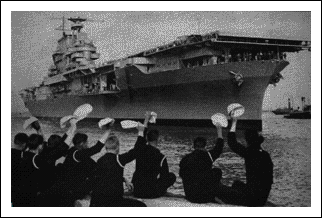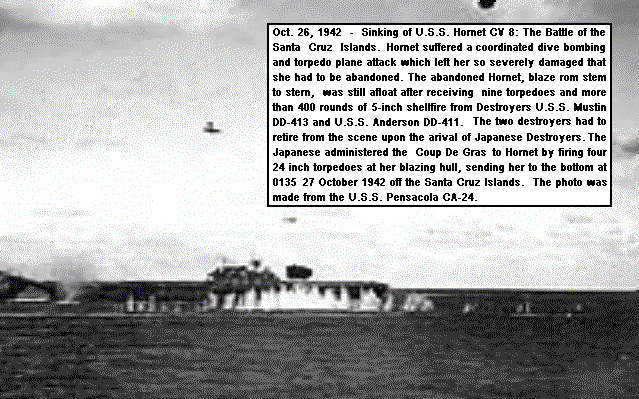|
The Hornet Legacy
Since the beginning of the United States Navy,
eight ships proudly carried the name Hornet.
Although little detail is known about the exploits and missions
of the early Hornets, available
information and accounts acknowledge them as some of the most
distinguished fighting ships in
American naval history.
In 1775, the first Hornet, along with
her sister ship the Wasp, became one of the first two ships in
the fledgling Continental Navy. The first Hornet, a converted
merchant sloop fitted out with nine
ten-pounder guns, established what was to become one of the most
distinguished names in
American naval history by her performance and gallantry in the
American Revolution.
In 1805, the second Hornet carried the
Marines to "the shores of Tripoli", and in a one-hour
canon duel silenced the Citadel at Djerna and landed the Marines
in the deciding action of the
against the Barbary Pirates.
The sixth Hornet was a steel steam yacht
converted in 1898.
The keel for the seventh Hornet (CV-8),
authorized by the Naval Expansion Act of 1939, was
laid on September 25, 1939 at the Newport News Shipbuilding and
Dry Dock Co., Newport News,
Virginia. Commissioned on October 20th, 1941, the new carrier
was built as one of three ships of
the Yorktown class. As with her sister ships Yorktown (CV-5)
and Enterprise (CV-6), she was 827
feet in length with a draft of 22 feet. Her flight deck was 114
feet wide and the beam of her hull
measured 83 feet. Her great turbines could propel her 20,000
tons up to 33 knots, while she
boasted a capacity of over 100 contemporary aircraft.
Hornet was at sea off Norfolk on her
shakedown cruise when the Japanese attack on Pearl
Harbor signaled the start of the war. Intensive training and
preparations began for the orders to
the Pacific that everyone aboard knew were soon to come. A hint
that those orders would be
delayed came on February 2, 1942 when two Army B-25 Mitchell
medium bombers were hoisted
aboard Hornet's deck in Norfolk. Hornet put to sea a few hours
later and the B-25's were
launched to evaluate the feasibility of these large land based
planes to take off from the confines
of a carrier at sea.
Hornet departed Norfolk on March 4th
en route to the West Coast via the Panama Canal,
arriving at Alameda Naval Air Station's pier two after a short
stop in San Diego. On April 1, 1942,
16 B-25s were towed to the dock alongside Hornet and hoisted
aboard. Lieutenant Colonel James
H. Doolittle and the 70 officers and 64 enlisted men of his squadron
reported aboard. Hornet's
crew assumed they were ferrying the bombers to Hawaii or some
other South Pacific island.
Hornet and her screen of escorts sailed under
sealed orders on April 2nd as "Task Force 16.2".
That afternoon captain Marc Mitscher came over the ship's public
address system and informed
the crew that the Army pilots were being transported across the
Pacific where they would take off
to bomb Tokyo. Shouts of joy could be heard throughout the ship.
Task force 16.1, consisting of
the U.S.S. Enterprise (CV-6) and her escorts, joined Hornet on
April 13. Since Hornet's own
aircraft were tucked away on her hanger deck to make room to
B-25s, Enterprise's aircraft would
provide aerial patrol to protect the combined group.
Although the original plan was to launch
to B-25s on the 19th (400 miles from Japan), the sighting
of a Japanese picket ship on the morning of the 18th meant the
element surprise was gone.
Doolittle conferred with Halsey and the decision was made to
launch immediately even though the
Japanese coast was still 650 miles away. In spite of gale force
winds of 45 knots and 30 foot swells
that pitched the ship furiously, the 16 bombers were launch successfully.
The raid caused only
superficial damage, but was a boost to American moral in the
aftermath of Pearl Harbor. Of the 80
pilots and crewmen, 73 survived the raid. The Japanese executed
three of the seven men who died.
Hornet arrived at Pearl Harbor a week
later and set sail on the 30th two assist Lexington (CV-2)
and Yorktown at the Battle of the Coral Sea, but she arrived
too late to take part. After escorting
the damaged Yorktown to Pearl Harbor, she departed 48 hours later
with her sister carriers to
defend the Island of Midway against an unexpected Japanese assault.
During the Battle of
Midway, Hornet's entire torpedo squadron 8 was lost while attacking
the Japanese carriers. The
Yorktown was sunk as a result of a combined aerial and submarine
attack, while the Japanese lost
4 fleet carriers -- a loss from which they did not recover. |

